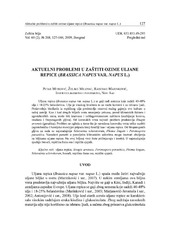Приказ основних података о документу
Current problems in the protection of winter rapeseed (Brassica napus var. napus L.)
Aktuelni problemi u zaštiti ozime uljane repice (Brassica napus var. napus L.)
| dc.creator | Mitrović, Petar | |
| dc.creator | Milovac, Željko | |
| dc.creator | Marinković, Radovan | |
| dc.date.accessioned | 2021-04-26T18:29:53Z | |
| dc.date.available | 2021-04-26T18:29:53Z | |
| dc.date.issued | 2009 | |
| dc.identifier.issn | 0372-7866 | |
| dc.identifier.uri | http://fiver.ifvcns.rs/handle/123456789/690 | |
| dc.description.abstract | The rapeseed (Brassica napus var. napus L.) is grown for seeds that contain 40-48% oil and 18-25% protein. The oil is high quality and it can be used for food. In our country, rapeseed oil is produced primarily for biodiesel. As with other crops, yield reduction may be caused by climatic factors and agricultural practices including a belated control of weeds, insects and phytopathogenic fungi. The wild mustard (Sinapis arvensis) is the major weed in the rapeseed, mostly because it comes from the same family and has similar genetic background as the rapeseed. The wild mustard causes multiple negative effects in rapeseed crop. The high content of erucic acid in mustard seed impairs oil quality, and the cake cannot be used as animal feed because of the presence of glucosinolates. Such oil renders low-quality biodiesel. Most herbicides are ineffective in the control of wild mustard in rapeseed crop. The rapeseed is also attacked by a large number of insect pests. Major pests in the fall are the cabbage stem flea beetle (Psylliodes chrysocephala) and the turnip sawfly (Athalia rosae). Both species may cause total damage. Major pests in the spring are the common pollen beetle (Meligethes aeneus) and weevils (Ceutorhynchus spp.). It has been reported that the activity of pollen beetle imagoes and larvae may reduce rapeseed yield up to 50%. One or more chemical treatments are needed to effectively control this pest. Second and third treatments may cause problems because they coincide with high activity of sensitive pollinating insects. Currently, the major phytopathogenic fungi are Sclerotinia sclerotiorum, Phoma lingam and Peronospora parasitica. The above pests are present in all rapeseed-growing regions. Although the damages caused so far have been negligible, the increasing frequency of pest occurrence seems to indicate that these pests may pose serious problems in rapeseed production in coming years. | en |
| dc.description.abstract | Uljana repica (Brassica napus var. napus L.) se gaji radi semena koje sadrži 40-48% ulja i 18-25% belančevina. Ulje je visokog kvaliteta te se može koristiti i za ishranu ljudi. Proizvodnja biodizela iz repičinog ulja predstavlja osnovni razlog gajenja ove kulture u našoj zemlji. Kao i kod drugih biljnih vrsta smanjenje prinosa, pored klimatskih faktora i agrotehničkih mera, može biti izazvano i neblagovremenom zaštitom (suzbijanje korova, insekata i fitopatogenih gljiva). Od korovskih vrsta najveći problem predstavlja Sinapis arvensis (gorušica). Problem se ogleda u tome što je navedenu korovsku vrstu teško suzbiti (agrotehničke i hemijske mere) jer pripada istoj familiji kao i uljana repica. Od fitopatogenih gljiva za sada su najznačajnije Sclerotinia sclerotiorum, Phoma lingam i Peronospora parasitica. Navedeni paraziti u povoljnim klimatskim uslovima mogu izazvati oboljenja na biljkama uljane repice. Na ovoj biljnoj vrsti štete pričinjavaju i insekti. U najznačajnije spadaju buvači, repičina lisna osa i repičin sjajnik. | sr |
| dc.publisher | Institut za zaštitu bilja i životnu sredinu, Beograd | |
| dc.rights | openAccess | |
| dc.source | Zaštita bilja | |
| dc.subject | rapeseed | en |
| dc.subject | Sinapis arvensis | en |
| dc.subject | Peronospora parasitica | en |
| dc.subject | Phoma lingam | en |
| dc.subject | Sclerotinia sclerotiorum | en |
| dc.subject | cabbage stem flea beetles | en |
| dc.subject | turnip sawfly | en |
| dc.subject | commonpollen beetle | en |
| dc.subject | uljana repica | sr |
| dc.subject | Sinapis arvensis | sr |
| dc.subject | Peronospora parasitica | sr |
| dc.subject | Phoma lingam | sr |
| dc.subject | Sclerotinia sclerotiorum | sr |
| dc.subject | buvači | sr |
| dc.subject | repičina lisna osa | sr |
| dc.subject | repičin sjajnik | sr |
| dc.title | Current problems in the protection of winter rapeseed (Brassica napus var. napus L.) | en |
| dc.title | Aktuelni problemi u zaštiti ozime uljane repice (Brassica napus var. napus L.) | sr |
| dc.type | article | |
| dc.rights.license | ARR | |
| dc.citation.epage | 144 | |
| dc.citation.issue | 2 | |
| dc.citation.other | 60(2): 127-144 | |
| dc.citation.rank | M53 | |
| dc.citation.spage | 127 | |
| dc.citation.volume | 60 | |
| dc.identifier.fulltext | http://fiver.ifvcns.rs/bitstream/id/1535/687.pdf | |
| dc.identifier.rcub | https://hdl.handle.net/21.15107/rcub_fiver_690 | |
| dc.type.version | publishedVersion |


